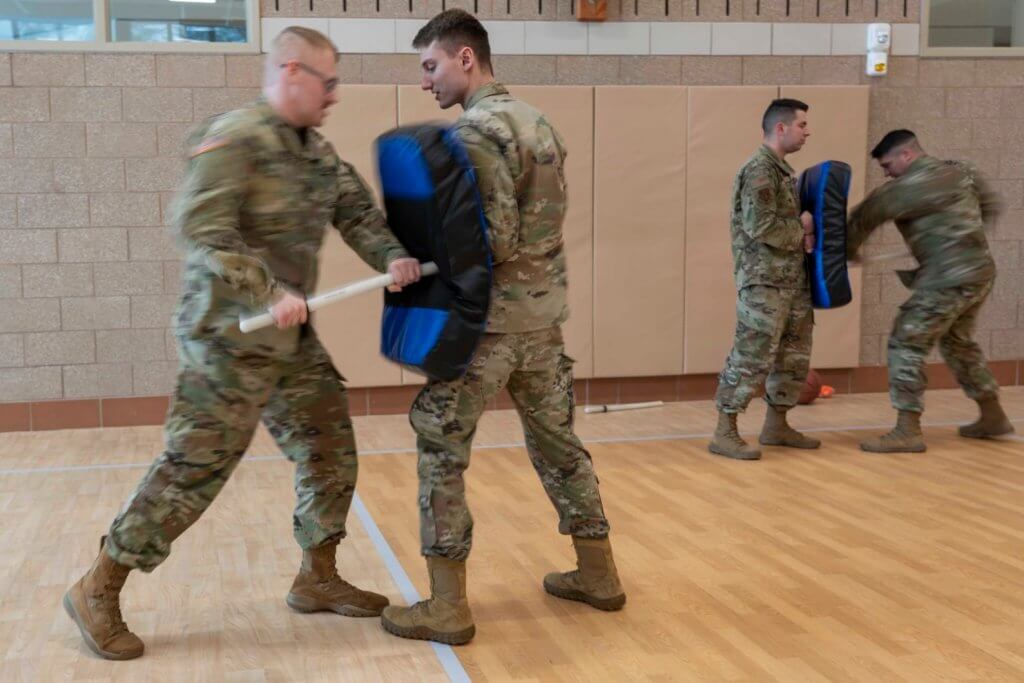As the COVID-19 pandemic heads into its third year, state leaders continue to name drop – and activate – the National Guard for missions outside its traditional scope, ranging from driving school buses and supporting prison operations to aiding Afghan refugees. The unique nature of these mobilizations has led to some policy changes, as was the case in the aftermath of last year’s Capitol riot.
Guard activations for prison staffing
A detachment of 25 New Hampshire National Guard soldiers and airmen was activated in January to fill staffing shortages caused by a spike in COVID-19 cases at the New Hampshire State Prison in Concord.
Guardsmen from the 157th Security Forces Squadron, 941st Military Police Battalion and 237th Military Police Company underwent more than 40 hours of specialized training at the New Hampshire Department of Corrections Training academy.
“The training has been very thorough,” Airman 1st Class Joshua Pincince of the 157th SFS, said in a press release. “It has been a lot of classroom, going over policies and what to expect, as well as a good amount of combatives.”
Guard personnel are expected to remain at the prison through the beginning of April.
Hospitals in the wake of the COVID-19 surge
The latest COVID-19 surge has depleted health care staff at hospitals throughout the country. As a result, governors in several states have issued Army and Air National Guard activations to fill in these gaps.
On Jan. 5, Maryland Gov. Larry Hogan ordered Guard activations for 1,000 members to help with staffing needs at health care facilities impacted by COVID-19 omicron variant surge.
“The Maryland National Guard is currently focused on supporting the Maryland Department of Health and other state agencies with missions for COVID-19 testing, supporting local hospitals and skilled nursing facilities, and assisting with non-life-threatening patient transport during the state of emergency due to a surge in COVID-19 hospitalizations,” Capt. Ben Hughes, USAF, Maryland National Guard Public Affairs Officer, said in an emailed statement.
According to a press release, guardsmen will assist with opening 20 hospital-adjacent testing sites across the state to help divert people from visiting hospital emergency rooms and meet the rising demand for COVID-19 testing.
On Jan. 12, Oregon Gov. Kate Brown announced that 1,200 ARNG troops would be mobilized to fill staffing needs at 50 hospitals across the state.
“These soldiers and airmen will be helping in non-clinical support roles in hospitals throughout Oregon,” said Maj. Chris Clyne, Public Affairs Officer for the Oregon National Guard.
Guard personnel, many of which will be staffing hospitals in the Portland area, are expected to be on orders for 90 days, or longer, Clyne said.
This is the largest domestic mission the Oregon National Guard has taken part in since 2005, when Hurricane Katrina made landfall in New Orleans, Louisiana.
Long-term implications of Capitol riot
One year ago, an estimated 25,000 soldiers from New York, Delaware, New Jersey, Virginia, Montana, Texas, Florida, Maryland, New Hampshire, and Washington, D.C., were deployed to the nation’s Capitol, after protesters stormed the U.S. Capitol Building as lawmakers certified the November 2020 Electoral College results.
Maj. Aaron Thacker, public affairs officer for the Washington, D.C., National Guard, said nearly all members of the District’s National Guard took part in the mission at the U.S. Capitol Building, which formally ended in May 2021.
Unlike other National Guard commands, the District of Columbia isn’t a state and does not have a governor, but falls under federal jurisdiction. When thousands of protesters overwhelmed the capitol building, the response fell under the D.C Guard, which reported to the U.S. Army Secretary.
Shortly after the incident, the Pentagon launched a months-long review of how requests for assistance for National Guard support are handled in Washington, DC. The review, which Defense Secretary Lloyd Austin requested, modified a 1969 memorandum that gave control of DCNG activation to the Army and Air Force Secretaries and placed control of the DCNG under the defense secretary.
Operation Allies Welcome
Guard activations occurred across the country in response to Afghan refugees escaping their home country following the Taliban’s takeover in 2021. As U.S. troops withdrew from the country, the Taliban began regaining control, devastating the country in August when it attacked the Kabul airport.
Soldiers and airmen assisted with processing, transportation and medical care, among other duties. Refugees were temporarily relocated to eight military installations.
“We have so many people who have been connected to Afghanistan the last 20 years and want to help in any way they can,” Air Force Lt. Col. Lisa Weaver, with the Air Component Coordination Element of the Washington National Guard, said in a news release.
The Department of Homeland Security has reported that more than 84,000 Afghan nationals, American citizens and permanent residents have come to the U.S. as part of the operation. Of those, 57,000 Afghans have relocated to communities throughout the country.

